Lithops Watering Schedule: A Guide
Lithops, the amazing plants also known as living or flowering stones, are like little treasures in the world of succulents. With their vibrant colors and fascinating shapes, they can instantly enhance the beauty of any garden. The best part? These adorable plants are incredibly easy to take care of. They don’t demand constant pampering, extravagant feedings, or aggressive trimming. But there’s one thing you need to be cautious about: watering.
When it comes to watering lithops, many people are curious about the right way to do it. The secret to successfully nurturing these succulents lies in understanding their watering needs. Knowing when to water them and when to hold back is key. So, let’s explore the realm of lithops and discover the watering secrets that will help them flourish.
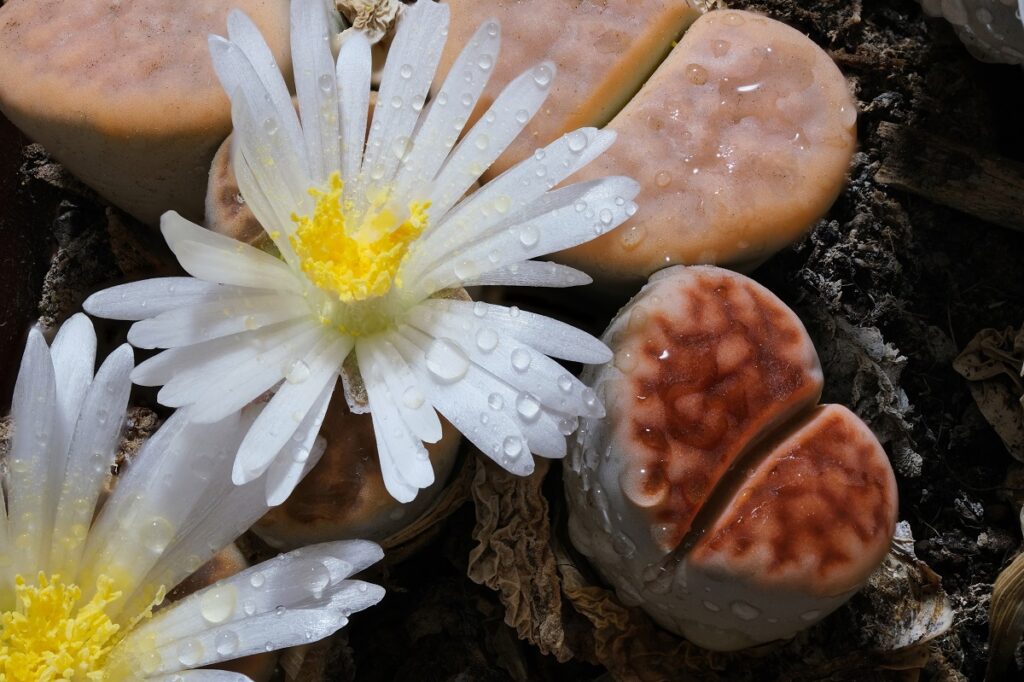
Contents
How to Determine When to Water Lithops
Knowing when to water your lithops can be a bit tricky since these plants are sensitive to overwatering. But don’t worry, there are simple ways to figure out if your lithops need water. One method is to check the soil moisture by sticking your finger into the soil. If it feels dry about 1-2 inches down, it’s time to water. On the other hand, if the top layer of soil is still wet or moist, it’s best to wait a bit longer before watering. You can also use a wooden stick to check the depth of soil dryness.
Another way to tell if your lithops is thirsty is by examining its leaves. If the leaves start to wrinkle and shrink, it’s a sign that your plant needs some water. But if the leaves are firm and plump, it means your lithops is getting enough water.
During the summer, lithops go into a dormant phase where their growth slows down or stops. It’s important to leave your plant untouched during this time and avoid watering it. However, if you notice the leaves shrinking, you can give it a small amount of water so that only the top inch of soil becomes slightly damp. Lithops are incredibly resilient and can retain moisture well, so they don’t require much attention from you during dormancy.
As autumn approaches, your lithops will enter a new growth period and will need more frequent watering. Watering approximately once every two weeks or when you see the leaves separating and indicating blooming is ideal. This is an important phase for your plant, as blooms signify its ongoing health. Pay close attention to your lithops during this growing period to ensure it thrives.
During the winter, it’s crucial to let your lithops go through its dormancy period. The old leaves will dry up and fall off while new ones develop inside the plant. Providing too much water during this stage can hinder the growth of the fresh leaves, so it’s best to limit watering even if it feels counterintuitive. Allowing the plant to rest during this time is beneficial and will ultimately contribute to its long-term well-being.
What does a thirsty lithops look like?
Lithops can go without water for months, so it’s better to err on the side of caution when watering them. When a lithops is thirsty, it will start showing signs of dehydration. The leaves may curl up, wrinkle, become brittle, or even sink into the pot. In severe cases, the leaves may crack or split open. Additionally, the plant may take on a grayish color due to the lack of water and nutrients. Give your beloved lithops a gentle squeeze; if it feels tender, it’s time to give it some water.
How Often Do You Need to Water Lithops?
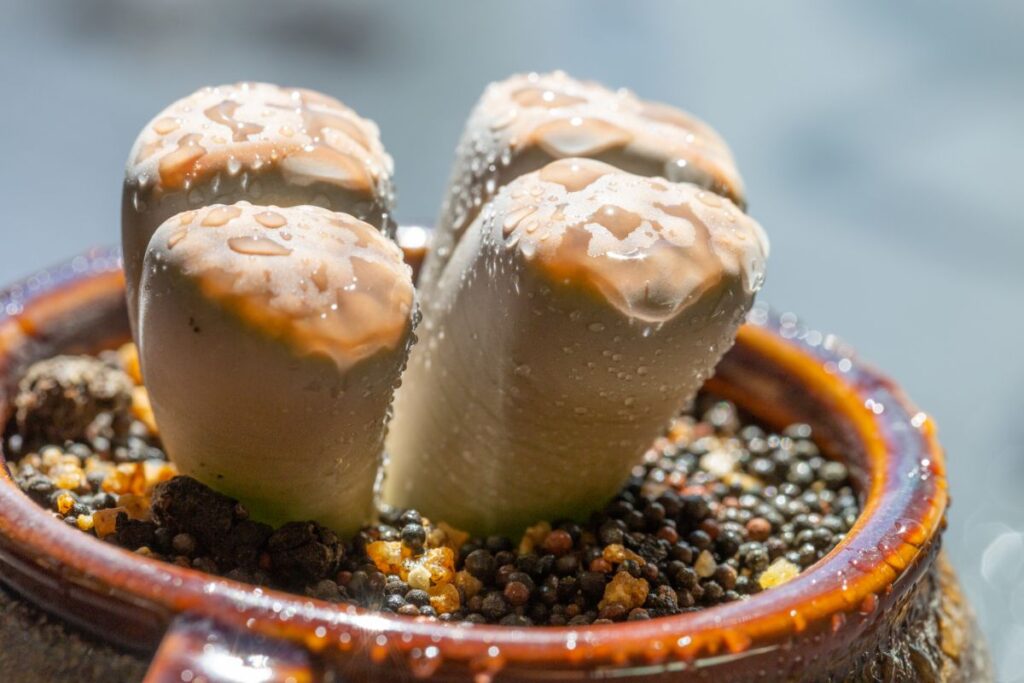
Lithops are unique plants that grow completely underground, lacking a stem, which helps them conserve moisture and thrive in dry conditions. To properly care for these special succulents, it’s important to follow the soak-and-dry water management method. This means saturating the soil with water and allowing it to dry completely before watering again. This approach will keep your lithops healthy and happy as it grows.
When caring for lithops, make sure to thoroughly water the soil and let it dry before watering again. Overwatering is a common cause of death for lithops, so be cautious.
The frequency and amount of water your lithops needs depend on its environment. During the growing season, watering once every one to two weeks is recommended. In winter, when lithops are dormant and not actively growing, you can reduce the amount of water and only water when the soil starts to dry out. Remember, never let your lithops sit in water, as this can lead to root rot and other issues.
No matter how often you water, it’s essential not to overwater your lithops. Overwatering can make the leaves soggy and cause root rot. If the soil is already damp when you check it, wait a few days before watering again. This ensures that your lithops maintains the right amount of moisture to thrive.
Do Lithops Like to Be Misted?
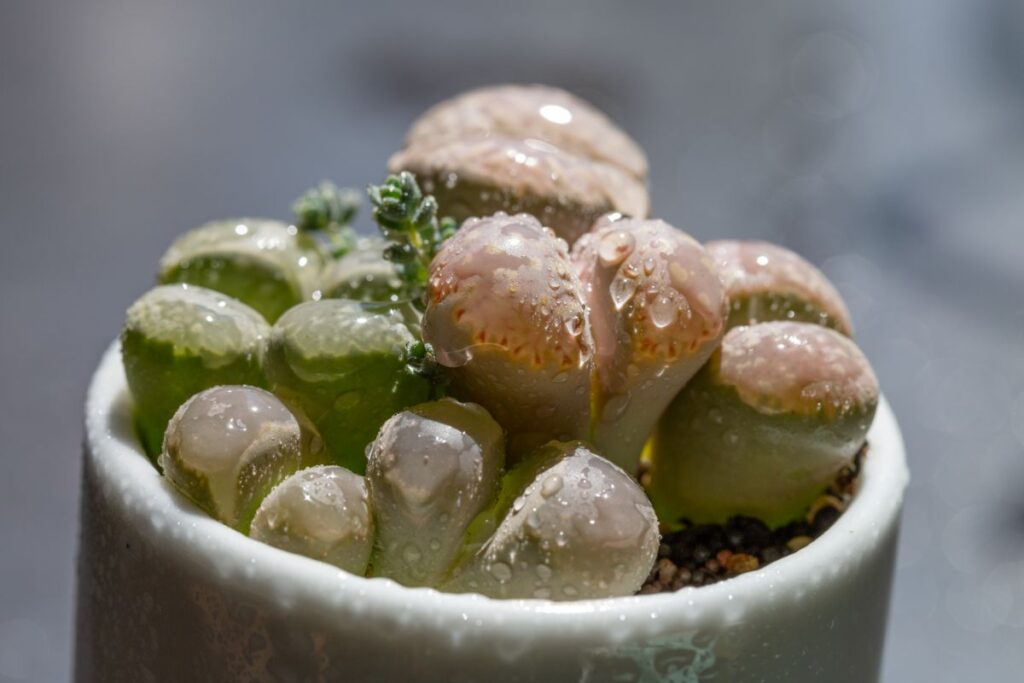
Misting lithops is not necessary since they do well in average humidity. In fact, misting can sometimes be harmful. Only mist your lithops if the air around it is too dry for optimal growth. Use a spray bottle filled with room-temperature water and lightly mist the leaves every few days.
Avoid saturating the leaves, as this can lead to rotting. If you choose to mist, do it in the morning, allowing any excess water to evaporate before nightfall. Consistent humidity levels are important for lithops, so avoid drastic changes.
Should You Water Lithops While Flowering?
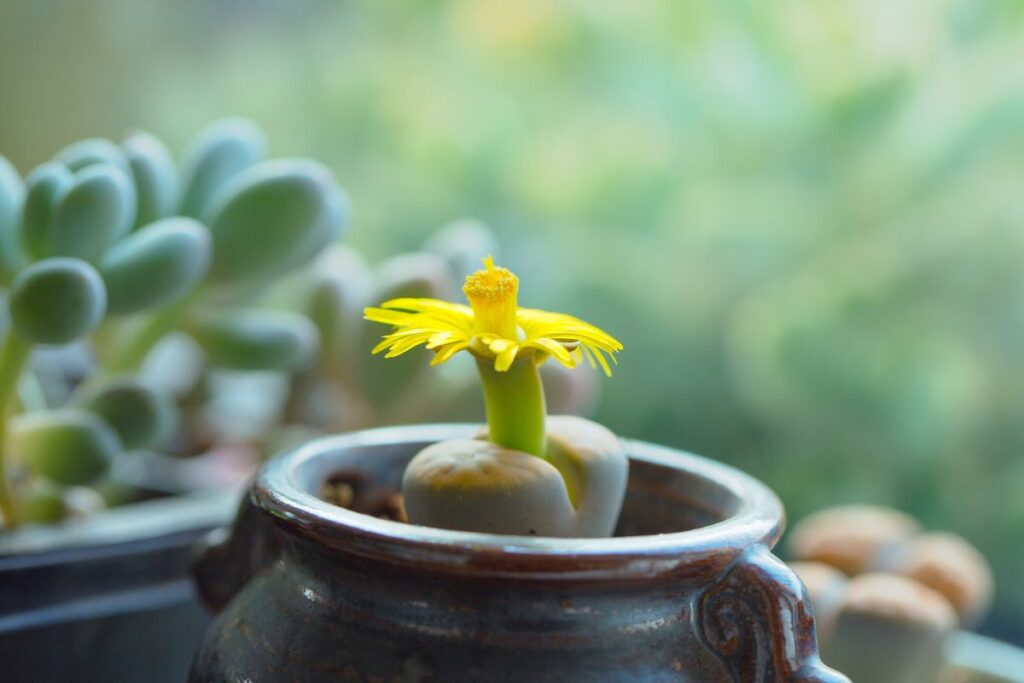
Lithops take water seriously, so it’s important to be mindful of their needs during the flowering stage. For optimal growth and health, only provide water once the old leaves have completely dried out, and stop watering once the flowers start to wilt. After flowering, new growth will emerge, indicating that the plant is utilizing water effectively. It’s crucial to create a watering schedule that allows the plant to go through its phases without over or under-watering.
During the growth and development phase, the new lithops plant relies on the old leaves for nutrients and water. The roots are inactive during this period, so providing excessive water can confuse the plant. It won’t know whether to absorb water from the roots or rely on the old leaves. This can cause the plant to become bloated and over-hydrated.
Once the old leaves have withered, it’s time for a thorough soaking. Allow all the water to evaporate before watering again. Monitor your lithops closely, and if there are no signs of wrinkling after a month, lightly moisten the surface of the soil. Avoid overwatering, as it can harm your plant.
After a month without wrinkling, approach watering carefully. Rather than drenching the soil, moisten the top layer to provide moisture for the roots. It’s important to strike the right balance between water and heat to prevent the roots from swelling and splitting, which can be fatal for the plant.
Should I Water Lithops in The Fall?
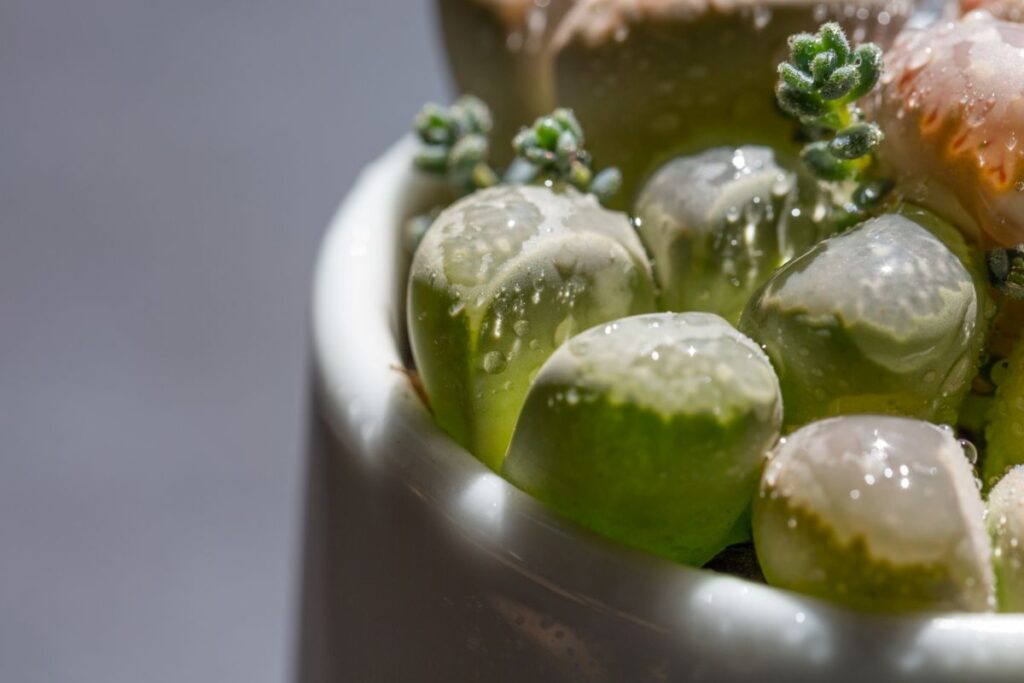
Starting in October, delay your watering routine until the current foliage has completely dried up, usually by May. During the summer dormancy season, avoid watering altogether. Wait until the old leaves have dried up before giving your lithops a thorough soaking once or twice a month. This ensures your lithops receives enough water without risking dehydration. Monitor the soil to ensure water absorption is consistent. If the soil stays damp for too long, reduce the amount of water you give to your lithops.
This period of rest and dormancy is crucial for the health and future growth of lithops. By following the recommended watering tips, you can ensure your lithops thrives year after year.
Should You Water Lithops While They’re Splitting?
It’s best to avoid watering lithops when they are splitting, as this can potentially harm the plant. The additional water absorbed by the old leaves can disrupt the usual leaf production cycle and harm the new leaves growing inside. Therefore, it’s best to leave your lithops alone while it goes through this growth process.
How Do You Know If Lithops Are Dormant?
Lithops typically enter dormancy as the nights become longer and colder. During this period, their leaves dry up and fall off, leaving behind a bare stem that doesn’t absorb water. This dormancy phase allows the plant to store energy and prepare for the next season of growth. You can tell if your lithops are dormant by examining the stem and leaves. If they feel dry and brittle to the touch, it indicates dormancy. If you notice any signs of wrinkling or dehydration, give your lithops a thorough soaking to support its dormancy period.
Conclusion
In conclusion, proper care and maintenance of lithops are essential for their health and longevity. By providing the correct amount of water, avoiding overwatering or underwatering, monitoring for signs of dehydration, and respecting their dormancy periods, you can bring out the best in your lithops and enjoy their beauty for years to come. Take the time to understand your plant, follow the guidelines provided above, and ensure it receives adequate nourishment for long-lasting results.
